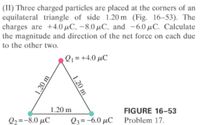Question
thumb_up100%

Transcribed Image Text:(II) Three charged particles are placed at the corners of an
equilateral triangle of side 1.20 m (Fig. 16-53). The
charges are +4.0 µC, -8.0 µC, and -6.0 µC. Calculate
the magnitude and direction of the net force on each due
to the other two.
Q1 = +4.0 µC
1.20 m
FIGURE 16-53
Q2=-8.0 µC
Q3= -6.0 µC
Problem 17.
1.20
1.20 m
Expert Solution
This question has been solved!
Explore an expertly crafted, step-by-step solution for a thorough understanding of key concepts.
This is a popular solution
Trending nowThis is a popular solution!
Step by stepSolved in 4 steps with 1 images

Knowledge Booster
Similar questions
- Problem 3: (II) Three positive particles of equal charge, +17.0 μC, are located at the corners of an equilateral triangle of side 15.0 cm (Fig. 16-53). Calculate the magnitude and direction of the net force on each particle due to the other two. FIGURE 16-53 +17.0 μC 15.0 cm 15.0 cm Problem 12. +17.0 με 15.0 cm +17.0 μСarrow_forwardi) A particle of mass 2.66×10-26 Kg travels at a speed of 5.0x106 m/s perpendicular to a field of flux density 1.20 T, which deflects it to move in a circular arc of radius 0.231-m. What positive charge is on the particle? (b) What is the ratio of this charge to the charge of an electron?arrow_forwardA 1.0C charge and a 2.0C charge are separated by 100m. Where should a charge -(1.0x10^-3) C° be located on a line between the positive charges so that the net electrical force on the negative charge is zero?arrow_forward
- please type out your solution so that it is easy to read I have bad eyesightarrow_forward(c) Calculate the electric field, E, at the origin for the three scenarios given. The magnitude 4760 of all charges is 3 C and the charges form squares with each side 1-m long. k = 8.99 x 10°Nm²/C². =arrow_forward(II) Two point charges, Q1 = -32 µC and Q2 = +45 µC, are separated by a distance of 12 cm. The electric field at the point P (see Fig. 16–57) is zero. How far from Qj is P? Q1 Q2 12 cm P -32 μC +45 µC FIGURE 16-57 Problem 32.arrow_forward
arrow_back_ios
arrow_forward_ios